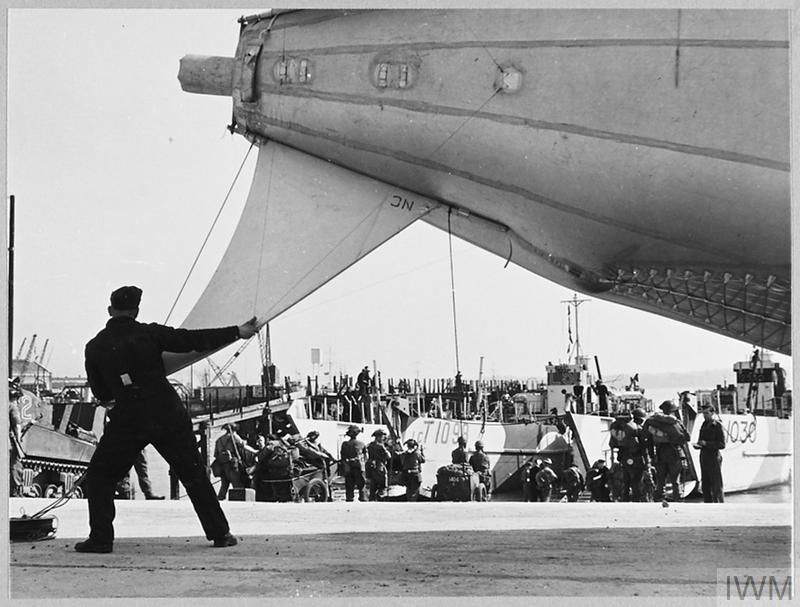
A despatch by Air Chief Marshal Sir Trafford Leigh-Mallory, K.C.B., D.S.O., Air Commander-in-Chief, Allied Expeditionary Air Force (A.E.A.F.), was submitted to the Supreme Allied Commander in November, 1944.
Leigh-Mallory opens with these words,
“On relinquishing my command of the Allied Expeditionary Air Force I have the honour to submit the following Despatch, covering its operations -under my command during the period from 15th November, 1943 to 30th September, 1944.”
This Despatch includes an explanation of beach-head balloon defences and extracts of the relevant paragraphs are shown below.
An early reference to beach-head balloon defences in this Despatch begins at paragraph 212.
212. Balloon Defence of the Beach-head. To supplement the defences provided by fighter aircraft and anti-aircraft guns, it had been decided to provide balloon protection for all beaches and artificial ports (Mulberries). It was thought that balloons would give valuable protection against low-flying attacks and would permit economies in the number of light A.A. weapons that would be needed in the early stages of the assault.
213. Operational control of these balloons was vested in the local A.A. Defence Commander. In practice, balloons flew at 2,000 feet by night and just below cloud base by day. Suitable control funnels, within which balloons were grounded by day, were arranged so as to avoid interference with approaches to air strips.
214. In Part IV of this Despatch I give further details of some of the difficulties experienced and overcome in planning the employment of these balloons. Here I need only comment on the results achieved. The passive nature of balloon defence and the monotonous lack of results make it difficult to compute its value. There were practically no reports of low-level bombing attacks by enemy aircraft during the periods the balloons were flying, and such bombing as did occur was scattered, doing little damage to the beach maintenance and none to the Mulberries. One enemy aircraft was destroyed by a balloon on the beaches in the U.S. sector. Apart from the positive value of balloons as a deterrent to low-flying enemy attacks, I feel that the presence of balloons has in itself, a definite morale value for both Naval and Army personnel.
In “PART IV—SPECIAL FEATURES” of the Despatch he begins,
“The mounting of air operations of the complexity and scale recorded in this Despatch was only made possible by an adequate ground organisation. I wish, therefore, in this Section to pay some tribute to the background work against which these operations were carried out, and upon which they depended for success.”
And beginning at paragraph 453 within this Section, he writes about
Employment of Balloons in the Assault Phase.
453. I have already referred to the reasons for using balloons for protection of the beaches during the assault phase and to the results achieved by their use. Here I think it proper to mention the reasons for the final choice of the Mk. VI (V.L.A.) balloon and also some of the difficulties experienced during the planning stages.
454. Mk. VI (V.L.A.) balloons flying normally at an operational height of 2,000 feet, were chosen for this work for the following reasons: –
- The extreme lightness of the ancillary equipment and the practicability of using a light hand winch which could be carried ashore by crews.
- The economy in operating personnel – only two airmen were required for each balloon.
- No extra initial lift was required as the balloons were transported flying.
- The possibility of transporting replacement balloons unmanned flying from L.C.T. and L.S.T.
- The comparatively small hydrogen requirements for maintenance and re-inflation.
455. During the planning stage it was realised there would be some difficulty in the employment of the balloons during the passage of the original assault forces. It was essential that balloons should not be brought in so early or at such a height as to give any premature warning on the enemy’s Radar system. Inter-Service agreement was made, permitting balloons to go into the beach-head flying at 100 feet, not less than seven miles behind the assault. This height is the worst possible at which to fly a balloon owing to its inclination to dive on encountering erratic air currents near the ground. It was decided, however, after experiments on exercises that this restriction was acceptable, and in the event, no undue casualties resulted.
456. A further problem solved in the preparatory phase was the manner of transportation of the planned number of 240 balloons for the British area and 145 for the American area. As the Navy proposed to carry balloons for their own protection on one-third of the L.C.T. and all of the L.S.T. it was necessary to devise a method of flying two balloons from each L.S.T. in order to have available the planned number in the beach-heads. After several experiments, this was accomplished.
457. To provide the necessary number of inflated balloons for each craft, to maintain them during the marshalling period and during any possible period of postponement, and to replace casualties during that time, require a large number of small vessels and extensive shore servicing and hydrogen organisation at all appropriate ports. These were comparatively easily provided in England from the resources of R.A.F. Balloon Command and the Admiralty Shore Servicing Section, but it should be remembered that such facilities, if not fortuitously available as in this case, have to be arranged.
This Despatch was published as a supplement to The London Gazette of Tuesday, the 31st of December, 1946 (Gazette Issue 37838).
It can be viewed at www.thegazette.co.uk
